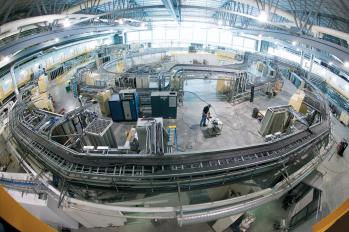
The Canadian Light Source (CLS), located on the University of Saskatchewan campus, is Canada's largest science research initiative in over 30 years. The first visible light from the facility was recorded on December 10, 2003, in a diagnostic beamline. Once fully operational, it will be one of the most powerful, third-generation synchrotrons in the world with over 30 operational beamlines. The $173.5-million project is a unique national facility that will provide numerous opportunities for science and innovation. The CLS, wholly owned by the University of Saskatchewan, is funded by federal, provincial, municipal, industrial and academic sources.
A synchrotron functions like a microscope with an extremely bright light--millions of times brighter than sunlight. Electrons are accelerated in a synchrotron at nearly the speed of light for an extended period in a closed system. The beamlines fit into groups of wavelengths including infrared, soft X-ray, and hard X-ray beamlines. Many components make a synchrotron operational: electron gun, linear accelerator (LINAC), booster ring, storage ring, synchrotron light, beamlines, optics hutch, experimental hutch, and work stations. The process involves injecting 220keV electrons into an ultra-high vacuum tube, then accelerating the electrons to nearly the speed of light. The electron beam is then transferred to the booster ring, where microwaves increase the energy to 2.9 giga-electron volts (GeV). From there, the electron beam is transferred to the storage ring at a current of 500 milli-amps, and bending magnets are used to accelerate and bend the beam many times to produce synchrotron light, which is then manipulated to investigate the structure of molecules.
There are many applications of synchrotron science: developing designer molecules for drugs; cancer research; studying the functionality of proteins, hormones, metabolic enzymes, bacteria, genes and viruses; creating materials such as hybrid metal alloys; trace-metal fingerprinting to manage natural resources; and developing micro-sensors and micro-machines for drug delivery systems.
Jessica Pothier